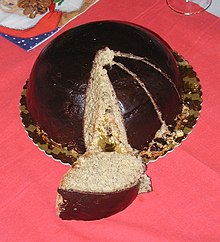 | |
| Course | Dessert |
|---|---|
| Place of origin | Italy |
| Region or state | Abruzzo |
| Main ingredients | Sugar, eggs, semolina, almonds, orange or lemon, dark chocolate |
Parrozzo (Italian: [parˈrɔttso]) or panrozzo (Italian: [ˌpanˈroddzo]) is a traditional[citation needed] cake from the Abruzzo region of Italy. It is traditionally served as a Christmas dessert, but may also be enjoyed year round.
Parrozzo is officially designated as a traditional food product of Abruzzo.[1]
Origins[edit]
Parrozzo was invented in 1920 by Luigi D'Amico, a bakery owner in Pescara. D'Amico wanted to create a cake that resembled the traditional rough bread made by local farmers with corn flour. Parrozzo has the same round shape as the bread, contains eggs to mimic the yellow of the corn, and is covered with a layer of dark chocolate reminiscent of the burnt surface of the bread.
The first person to try parrozzo was the poet Gabriele D'Annunzio. Afterwards, he composed a madrigal called "La Canzone del Parrozzo" (lit. 'The Song of Parrozzo'), written in Abruzzese dialect:
"È tante 'bbone stu parrozze nove che pare na pazzie de San Ciattè, c'avesse messe a su gran forne tè la terre lavorata da lu bbove, la terre grasse e lustre che se coce… e che dovente a poche a poche chiù doce de qualunque cosa doce…"
Ingredients and preparation[edit]
The dough of parrozzo is made of semolina (alternatively yellow or white flour with corn starch), sugar, eggs, ground almonds, almond extract, and orange or lemon zest. All ingredients are mixed and baked in a round aluminum tray. When the cake has cooled, it is removed from the tray and covered with molten dark chocolate.
See also[edit]
References[edit]
- ^ "Parrozzo". www.italyheritage.com. Retrieved 2023-12-22.
Bibliography[edit]
- Enrico Di Carlo, Gabriele d'Annunzio e la gastronomia abruzzese, Castelli, Verdone, 2010;
Well, that’s interesting to know that Psilotum nudum are known as whisk ferns. Psilotum nudum is the commoner species of the two. While the P. flaccidum is a rare species and is found in the tropical islands. Both the species are usually epiphytic in habit and grow upon tree ferns. These species may also be terrestrial and grow in humus or in the crevices of the rocks.
View the detailed Guide of Psilotum nudum: Detailed Study Of Psilotum Nudum (Whisk Fern), Classification, Anatomy, Reproduction